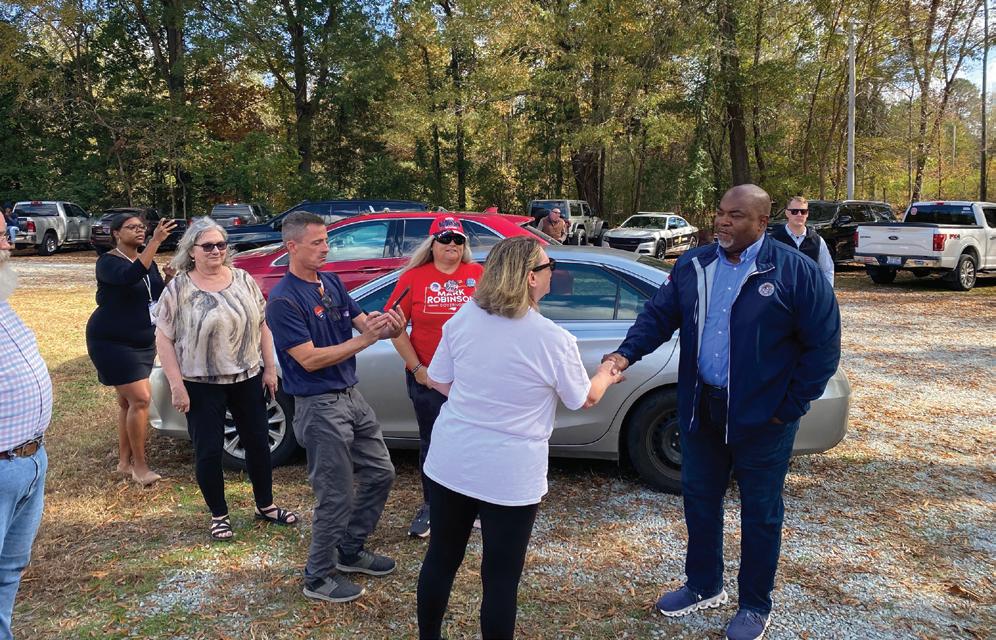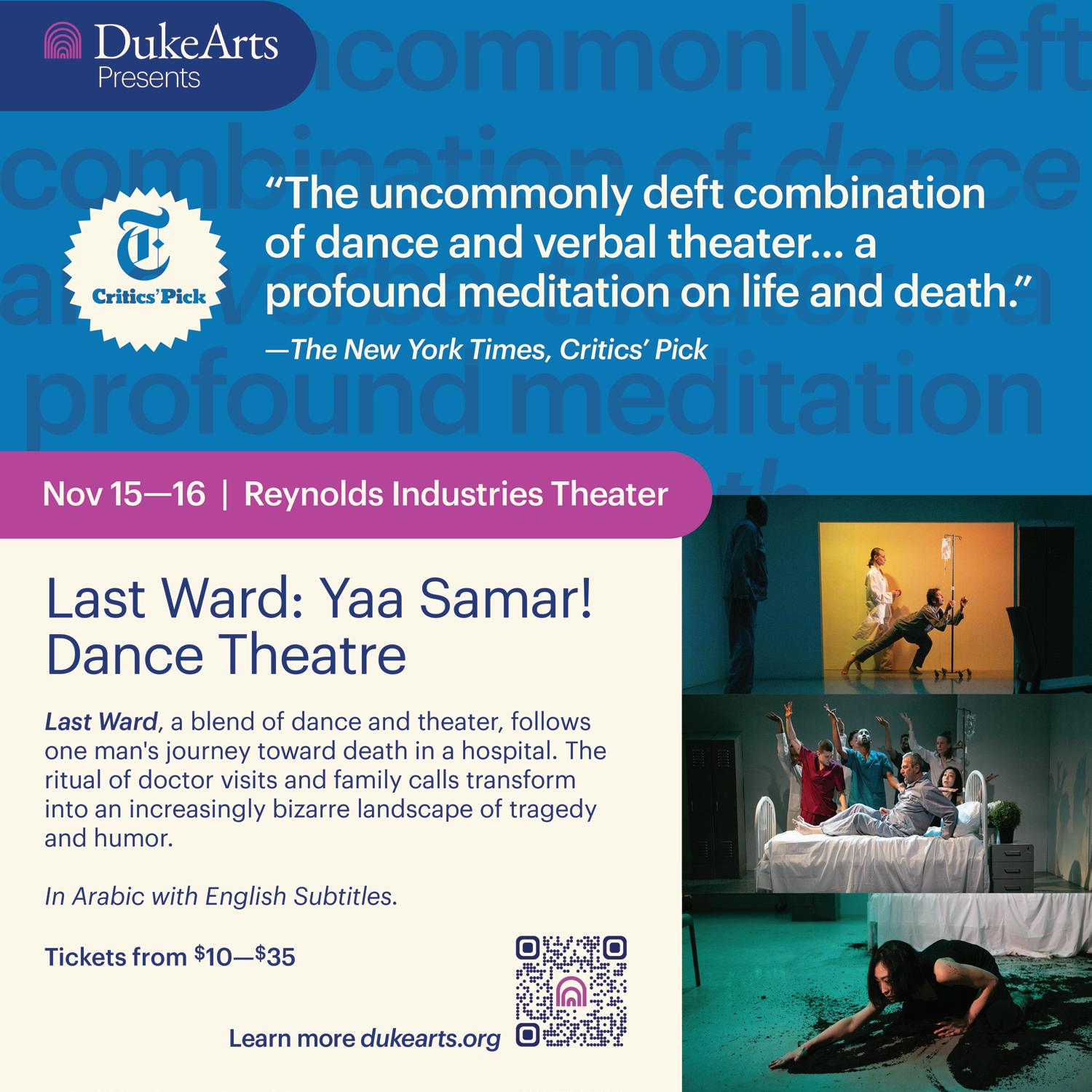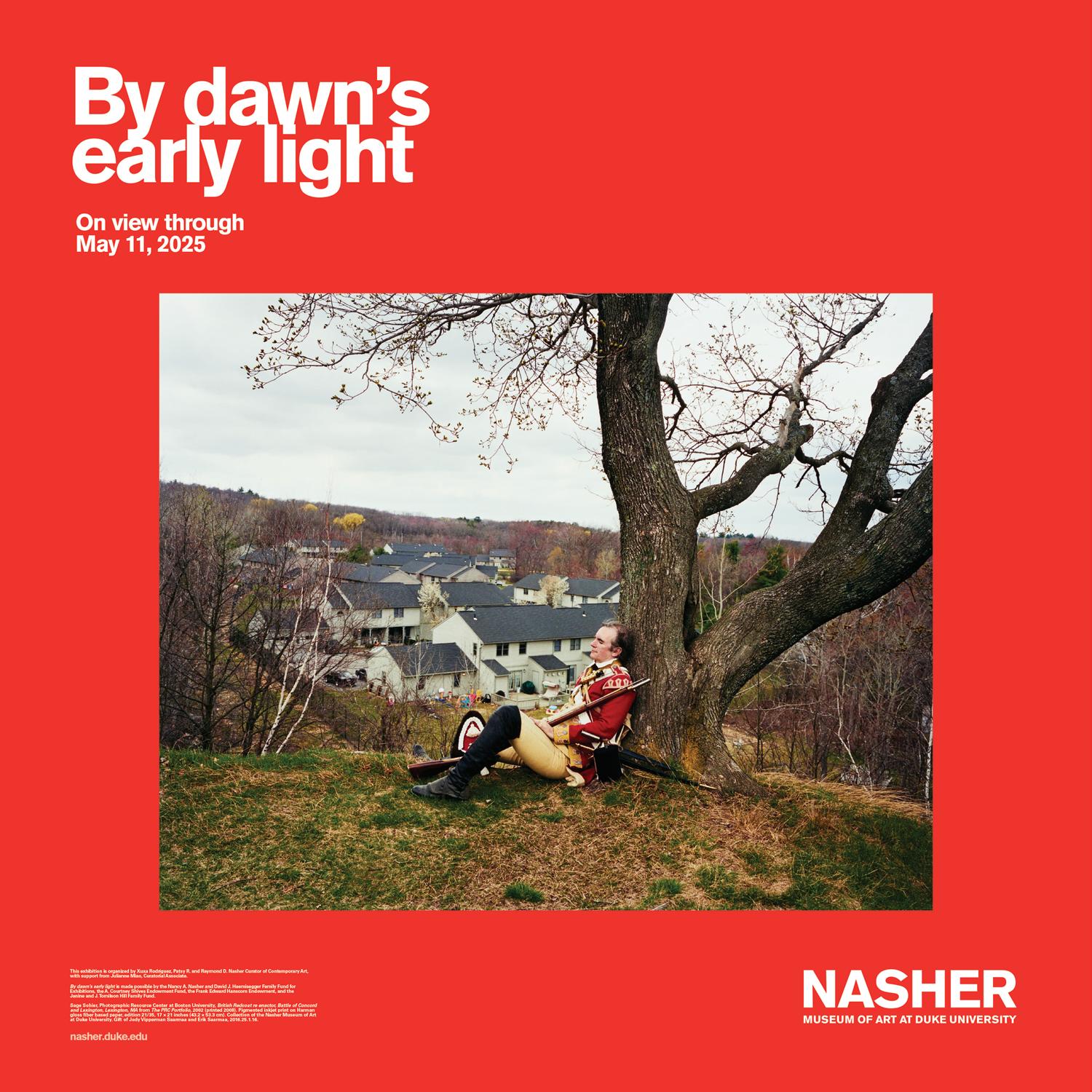November 13, 2024


November 13, 2024

Maya Freelon’s new exhibition at Historic Stagville reimagines the lives of enslaved children with a delicate medium that gives resilient dimension to their legacies. By Sarah Edwards, p. 10
4 Several City of Durham departments remain understaffed, but Durham's mayor says there are fewer vacancies than in the past. BY CY NEFF
6 Mark Robinson spent Election day and night in the Triangle—sanguine, defensive, and looking to the future. BY CHASE PELLEGRINI DE PAUR
8 Durham voters say yes to a water park and goodbye to dirt roads with the passge of a $200 million bond package. BY LILY KEMPCZINSKI
10 Whippersnappers, a new exhibition by Maya Freelon at Historic Stagville, is a moving, colorful reimagining of the lives of enslaved children. BY SARAH EDWARDS
14 "We wanted a place to make noise in": Shadowbox Studio celebrates ten years in Durham. BY GRACE YANNOTTA
16 Sean Baker’s Anora, dark zeitgeist comedy Rumours, a stop-motion film that’s not for kids, and more movies playing in the Triangle. BY GLENN MCDONALD
3 Backtalk 18 Culture calendar

Michigander performs with Cece Coakley at Kings in Raleigh. (See calendar, page 18.)
COURTESY OF CAT'S CRADLE
PUBLISHER
John Hurld
EDITORIAL
Editor-in-Chief
Jane Porter
Culture Editor
Sarah Edwards
Reporters
Chloe Courtney Bohl
Lena Geller
Justin Laidlaw
Chase Pellegrini de Paur
November 13, 2024
Contributors
Mariana Fabian, Jasmine Gallup, Desmera Gatewood, Spencer Griffith, Carr Harkrader, Matt Hartman, Tasso Hartzog, Brian Howe, Kyesha Jennings, Jordan Lawrence, Elim Lee, Glenn McDonald, Nick McGregor, Gabi Mendick, Cy Neff, Sam Overton, Shelbi Polk, Byron Woods, Barry Yeoman
Copy Editor Iza Wojciechowska
CREATIVE
Creative Director Nicole Pajor Moore
Graphic Designer Ann Salman
Staff Photographer Angelica Edwards
ADVERTISING
Publisher John Hurld
Director of Revenue
Mathias Marchington
Director of Operations
Chelsey Koch
CIRCULATION
Berry Media Group
MEMBERSHIP/SUBSCRIPTIONS
John Hurld
A C K T A L K
Two weeks ago, we published a story about accusations against Republican state lawmaker Erin Paré and her husband, Wayne, allegedly intimidating poll greeters at early voting sites during the past three election cycles and calling the police on poll greeters and constituents. We heard similar accounts from readers following publication. (Rep. Paré declined to comment for our story; Wayne Paré did not respond to requests for comment.)
From
DAVID REITMEYER:
… I am a poll worker, currently serving early voting at the Wake Tech Main Campus in this election, but was at the Hunt Center in 2022 and Hilltop for 2024 primaries.
Your description of their intimidating behavior is SPOT ON. However, the supervisors at these sites are not in a position to stand around outside all day and police this childish, intimidating behavior. They can only state the rules and ask poll greeters to conform to them—and call the [Board of Elections] or local police if the situation doesn’t improve. (And this was done several times in my shifts.)
I don’t know what’s next for these people, but I am SO sick of this nonsense. However, I fear that, if a certain party wins, it will only get worse.
From reader NICOLE THOMAS:
Thank you for the piece about Erin Pare.
Living in her district, my husband and I called her office to voice some of our concerns. Of course, we did not expect her to change her mind or point of view but we wanted to feel heard. And wanted to hear her reasoning.
No phone call response, no emails.
Admittedly, the last voicemail left was loud, but in no way shape or form threatening. And she called the capital police and filed a report.
That tactic worked, we lead busy lives, careers, etc.; and frankly we do not have the time or resources to buck up to this kind of behavior.
It just feels like she has ZERO interest in her constituents unless they fall in line, or are intimidated into backing down.
Paré was reelected to her seat.
We also heard from readers who appreciated our reporting on how UNC-Chapel Hill pursued disciplinary charges against student protesters.
From reader DALIA MOUAWAD:
I just wanted to share my appreciation for the incredibly detailed and honest review of the situations happening to students at UNC written by Lena Geller …. The article was so well written and has been some of the most fair and articulated reportings of the situation which has honestly been really hard to come by since this began. The brutality that has been inflicted by campus police and admin go way beyond and it means a lot that this story is covered for the safety of students and faculty.


Records show some City of Durham departments remain understaffed; mayor Leonardo Williams says there are fewer vacancies across departments citywide than in years past.
BY CY NEFF backtalk@indyweek.com
In Durham, several city departments are still understaffed.
Numbers released to the INDY in response to a public records request, originally filed in October 2023 and refiled in August 2024, show vacancies by department across the City of Durham. While the city initially declined to share vacancy numbers by department, released numbers dated to September 1, 2024, show a citywide vacancy rate of 16.44 percent, with 459 of the city’s 2,816 positions sitting empty.
The highest vacancy percentage belongs to the Emergency Communications Department, where over a third of the department’s 80 positions are unfilled. Department director Randy Beeman says that while the vacancy rate is high compared to that in other city departments, the intensity of the work is a barrier to recruitment, and the department is all-hands-on-deck with recruiting.
“It was bad, and it’s gotten better. If you look at the data over the last 10 years, you’ll see it’ll be up, it will take a significant dip, and then you’ll see changes made.”
“It is very hard work. It is the nature of the work,” Beeman says. “We are very diligent and very focused on recruitment and training in support of reducing our vacancies.”
The Durham Police Department has one of the highest vacancy rates as well, with nearly 30 percent of positions, 198 of 676, sitting empty. Vacancies in the police department have drawn attention from local media, with the city council voting earlier this year to raise pay for police officers in an effort to bolster recruitment. Durham is also known for its alternative approaches to policing, notably its growing HEART program, which falls under the Community Safety Department. That department reported two vacancies out of 47 positions.
Some of Durham’s smaller departments are fully staffed, such as the City Attorney’s Office (13 positions) and the City Clerk’s Office (eight positions). The largest
Mayor Leonardo Williams says there are fewer vacancies currently than in past years, and he cites factors including the pandemic, the “Defund the Police movement,” and past protests over worker pay as reasons for low staffing in the past.
“It was bad, and it’s gotten better,” Williams says. “If you look at the data over
the last 10 years, you’ll see it’ll be up, it’ll take a significant dip, and then you’ll see changes made—and you’ll see it started to creep back up.”
The INDY was unable to verify Williams’s claim. The INDY filed another request with the city following its interview with Williams and was told again that vacancy numbers for prior years remained unavailable. W
The full departmental vacancy list is as follows:



With the writing on the wall about his gubernatorial campaign’s electoral chances, Mark Robinson spent Election Day and night in the Triangle—sanguine, defiant, and looking toward the future.
BY CHASE PELLEGRINI DE PAUR chase@indyweek.com
By noon on Election Day, even before votes were counted, lieutenant governor Mark Robinson seemed to be already slouching toward his own second coming.
“[The campaign] has been a long, tough process, but I’m probably going to look back when it’s over and go, ‘Gosh, I miss that, I want to do it again,’” he told reporters outside the Caldwell Community Building, a polling site in rural Orange County.
Everyone chuckled.
The often-combative candidate with a history of violent, religious rhetoric sounded blissfully at ease during one of his last campaign stops. He slowly made his way through the small gathering of Republican volunteers, shaking hands and thanking them for their work.
“Mark, you look tired,” one of the Republican volunteers said. “You doing OK?”
Robinson, hoarseness evident in his voice, laughed and said he’s “tired but good.”
After he finished greeting the Republican volunteers, he reached across the aisle—a small strip of concrete that separated the Republican and Democratic tents— and offered his hand to the Democratic workers.
“I’m not voting for you,” said one of the Democrats while shaking his hand.
“Hey, that’s how it works,” said Robinson with a small smile.
On Robinson’s way out, a supporter thanked him for running. “We know the forces of hell that are coming against you,” the supporter said.
“That’s right, that’s exactly right,” said Robinson. Robinson, of course, lost the election by 15 points

statewide.
And while he did win a majority of votes in the Caldwell precinct he visited on Election Day, he certainly lost the Orange County vote as most moderate-to-conservative precincts joined the progressive anchors of Chapel Hill and Hillsborough to reject him by more than 60 points.
Still, on election night, the roughly 70 core supporters at Robinson’s watch party at Raleigh’s swanky City Club— overlooking the state capitol building from 29 stories above—did not seem daunted by the impending landslide.
There was no vibe shift or loss in confidence among the true believers even when Fox News called the race against Robinson only six minutes after polls closed. Supporters calmly sipped wine and ate appetizers, watching national results roll in on Spectrum News.
“I haven’t seen Mark yet,” said one elegantly dressed woman who declined to be interviewed.
About an hour later, campaign staff started steering partygoers toward a room with a podium while an aide passed out pink “Women for Robinson” signs and red “Robinson for governor” hats.
When Robinson took the stage, he delivered a defiant concession, tying his political crusade to his faith and assuring supporters that the future was still bright.
“As always, very first thing we’re going to do is what?” he asked the audience, a crowd diverse in race, though certainly skewing older in age.
“Thank God!” they shouted back.
“It doesn’t seem like it’s going our way tonight,” he said, acknowledging the loss of a political battle. But when audience members cried out in disbelief, he held
up a finger for silence and reminded them of the larger, biblical movement.
“But it’s always going our way, because it’s going the right way, whether people want it to or not. People of faith know it’s going the right way because we read the back of the book and we know how this all comes to an end. Those who would promote evil and promote wrong and call it right—they do not win. They may prosper for a season but in the end, we win.”
And, while he said he was looking forward to spending time with his grandchildren, he also hinted at a future run.
“It is about the state that you love, the state that I fully intend to continue to serve for the next two months and, who knows, maybe in the future once again, somewhere in office, who knows, I don’t know.”
(The Assembly reported that North Carolina politicos are already imagining a 2026 U.S. Senate primary between Robinson and two-term incumbent Thom Tillis.)
Durham resident Joetta MacMiller told the INDY that she would certainly support another Robinson run. MacMiller has been a fan since the 2018 Greensboro City Council speech that put Robinson on the political map.
“He came out and he was saying a lot of the same things that we all were thinking, but he voiced it. And he was firm, and he was standing up for every one of us,” MacMiller said.
After his speech, Robinson and his wife, Yolanda, made a round of the room to embrace their faithful few. And in the corner, five supporters clasped hands in prayer.
“This isn’t the end,” intoned one. “It truly is a beginning.” W


Hello, water park; goodbye, dirt roads: Durham voters approved $200 million in bonds.
BY LILY KEMPCZINSKI backtalk@indyweek.com
Durham voters said yes to building a new water park, paving nearly 10.85 miles of dirt roads, constructing 12.4 miles of new sidewalks, and other parks and transportation improvements last Tuesday. The bonds total $200 million and are expected to raise property taxes by about $34.50 on a $100,000 home—3.46¢ per $100 of assessed value.
Voters approved two separate measures: $85 million for parks and recreation bonds and $115 million for streets and sidewalks bonds.
The parks and recreation bonds will be used for renovations at Long Meadow Park and East End Park, as well as building a large aquatic center next to Merrick-Moore Park. Long Meadow Park and East End Park were initially segregated, accessible only to white and Black residents, respectively. With the renovation, a new trail will connect Long Meadow and East End, which the Durham Parks Foundation says will “symbolically unite these two parks.” Other renovations include a replacement pool at Long Meadow
Park and additions to the athletic facilities at both parks.
The new aquatic center—which will be next to Wheels Roller Skating Rink and across the street from Merrick-Moore Park—is set to include a lazy river, water slide, and multiple pools. When the aquatic center and Wheels Roller Skating Rink projects are complete, the entire complex plus the current park will be considered Merrick-Moore Park.
The park renovations are all projected to open in the summer of 2028, according to the city.
The streets and sidewalks bond will add 12.4 miles of new sidewalks across 25 locations identified in the city’s 2017 Bike+Walk Plan. Additionally, the bond will fund improvements to approximately 20 miles of sidewalks. The repairs are expected to start either in the summer or fall of 2025 and “could take up to two years to finish,” according to the city.
The bond also will repave and repair around 100 miles of Durham streets and newly pave almost 11 miles of dirt
roads. The repave and repair projects will likely begin in the summer of 2025 and take two construction seasons, while the new paving projects are expected to finish closer to 2029.
The increase in Durham property taxes from the bond referendum will begin in 2026 and slowly decrease over the next 20 years, according to the city.
The measure was championed by Durham elected officials, including all members of the city council, as well as the group Bike Durham.
“Most of us in Durham want to live in a community that is inclusive and thriving, and a complete network of sidewalks and safe streets is a big part of that,” says John Tallmadge, director of Bike Durham. W
This story was published through a partnership between the INDY and 9th Street Journal, which is produced by journalism students at Duke University’s DeWitt Wallace Center for Media & Democracy.

Whippersnappers: Recapturing, Reviewing, and Reimagining the Lives of Enslaved Children in the United States Nov. 16-Jan. 25 | Historic Stagville, Durham
Maya Freelon’s new exhibition at Historic Stagville reimagines the lives of enslaved children with a delicate medium that gives resilient dimension to their legacies.
BY SARAH EDWARDS sedwards @indyweek.com
At an empty house on the rural outskirts of Durham, a slip of color flutters persistently in a window. Through the warped glass of the house—the Bennehan Home at Historic Stagville, built in 1799— the color appears ghostly; a trick of light.
This vision is from artist Maya Freelon’s tissue-paper sculptures, which sprawl throughout the former plantation in a site-specific exhibition, activating the rooms with figures and scenes. Entitled Whippersnappers: Recapturing, Reviewing, and Reimagining the Lives of Enslaved Children in the United States, the show opens November 16 and runs through January 25.
“The exhibition is about the preciousness and the joy of childhood,” Freelon says. “How a child can find a happy place in anything. They’re able to exist in terrible conditions and still be resilient.”
Dozens of Freelon’s archival photo monoprints are on display, made with her signature “bleeding” tissue paper technique. Some photographs are sourced from Jess Vanhook, Freelon’s romantic partner and collaborator. Vanhook’s grandmother kept an extensive archive of family photos throughout the 20th century—scenes of Black life in sweet, casual repose.
“My grandma makes photo albums for everybody,” Vanhook says. “Everybody in these photos I’m pretty sure has a copy, but she keeps one for herself, too.”
Other photographs are sourced from the U.S. Library of Congress, which funded Whippersnappers through its Connecting Communities Digital Initiative.
While researching at the Library of Congress, where she was a 2024 artist/
scholar-in-residence, Freelon searched for 19th-century photographs of Black children shown in happy moments—rare images, though a precious few, like a sunny photograph of a small Black girl laughing in a field, have slipped through the cracks of history. Freelon reimagines that photo as “Beautiful Flower,” an image overlaid with collaged tissue, as if caught in a swirling vortex of time and color.
The intention with Whippersnappers, Freelon says, is to make Black history— one still actively repressed and erased— feel more alive, as she evokes the playful, hopeful spirit of children facing unbearable circumstances.
Michelle Lanier, director of the NC Division of State Historic Sites and Properties, says the exhibit is a first at Historic Stagville.
“We’ve been imagining the possibilities of activating spaces,” Lanier says, “particularly spaces that have been touched by the stories of people who lived in human bondage.”
Lanier adds that she feels particularly connected to the project because her ancestors were, as she calls it, “landkin” to Stagville—enslaved people who created lives and families in places much like this.
“We see the visual arts as a powerful invitation for people to come close to narratives that are traumatic,” she continues. “In the experience of the art there is a possibility for medicine, for healing.”
“I could’ve just left it at ‘Whippersnappers,’” Freelon says of the project’s title. “But I wanted people who read it to say out loud—that children were enslaved here not that long ago.”

“Here” could be countless geographies touched by the transatlantic slave trade. Today, the reference is to Historic Stagville.
To get here from Durham proper, you will drive down Old Oxford Road, snaking along the Eno River, past farms and the ominous-looking confines of Treyburn corporate campus. At one time, this land—owned by the powerful Bennehan and Cameron families, united in 1803 by the marriage of Duncan Cameron and Rebecca Bennehan— was another kind of massive complex, with farms, workshops, and mills sustained by the unpaid labor of enslaved people.
At their peak, the Cameron-Bennehan landholdings were 30,000 acres, a swath of piedmont land encompassing parts of what are now Wake, Durham, and Granville Counties. By 1864, Stagville was one of the wealthiest plantations in the South and the largest site of mass slavery in the state, with more than 900 people enslaved (and dozens more enslaved at other Cameron properties). The state now owns a fraction of the estate: 165 acres, preserved as an educational site.
Historical tours sometimes manage to romanticize the era, with cheery docents cradling wicker baskets; this experience, however, is much more thoughtful. It begins in Horton Grove, where enslaved families were kept, and outlines the experiences— the great suffering from forced family sep-
arations, as well as the many forms of resistance carried out—of the generations who lived there.
On an original chimney at Horton Grove, our guide, a volunteer named Liz Henderson, points to bricks bearing thumbprints of the enslaved people who worked on it. There are also five pea-sized toe prints: the footprint of a young enslaved child.
Here, after news reached that Robert E. Lee had surrendered in 1865, enslaved people gathered for a midnight vigil. According to the autobiography of enslaved person Morgan Latta, who was 12 at the time: “Husbands prayed that they might see their wives again, and the wives prayed that they might see their husbands again, and the children prayed that they might see their parents again, and also their sisters and brothers.”
Two weeks later, the last major surrender of the Confederate army occurred at Bennett Place, about 12 miles south of Stagville, effectively ending the Civil War.
The weather is beautiful today, mild and pacific. Our tour winds through a grove—all new; this would’ve all been farmland 200 years ago—to a white barn that enslaved craftsmen built by hand in 1860. Henderson draws our attention to a massive pine beam shouldering the length of the interior—an old-growth forest tree.
It’s Tuesday, which means it’s also Election Day; timing that is coincidental (tours































are unavailable on Mondays) but nevertheless makes the landscape feel freighted with meaning. Evidence of an old-growth forest makes Stagville feel old; the young trees, and ongoing events of the election, make it feel young.
As the tour wraps up, Henderson asks if anyone has questions. An older woman teasingly pokes at Henderson: “It doesn’t seem like you like the Camerons very much, do you?”
Henderson replies that the research she’s done makes that a bit hard. She mentions Paul Cameron’s reputation for violent drop-by visits at Horton Grove and emphasizes that plantation owners’ wives were also culpable, often reinforcing their husbands’ violence.
The woman presses on. “But not all slave owners were violent, right?” she asks. “Like, there must’ve been a range?”
Henderson is quiet for a moment. “I think,” she finally says, “that the act of owning another person is always inherently violent.”
With that, the tour is done. Everyone continues with the day, awaiting election results.
Maya Freelon was born into a profoundly artistic heritage: her parents are prodigious jazz musician Nnenna Freelon and renowned late architect Phil Free-
lon; her grandfather Allan Freelon was an educator and impressionist painter. Her grandmother Franny, as Freelon writes on her website, taught her granddaughter to quilt, reminding her that “we came from a family of sharecroppers that never got their fair share.”
Freelon has used tissue paper as a medium since she was in graduate school at the School of the Museum of Fine Arts in Boston. There, while living with her grandmother, she stumbled upon a stack of papers that had, over time, been transformed by the elements—leaks from a pipe streaking colors between the pieces, blurring their boundaries. She was mesmerized.
Numerous museums, including the National Gallery of Art and the National Museum of African American History and Culture, have since featured Freelon’s work. She is named for her godparent Maya Angelou—a close friend of her grandmother’s— who once described the paper sculptures as “visualizing the truth about the vulnerability and the strength of the human being.”
That balance of fragility and resilience is evident in Whippersnappers. An otherwise cheap item—$1.99 at drug stores, held together with Elmer’s glue—resourcefully transforms a site of violence into a prism that refracts hidden histories outward.
The sculptures will be on display in six rooms of the Bennehan house, as well as
in the barn, accompanied by a “motion-activated soundscape composition” created by Nnenna Freelon and ethnomusicologist
Allie Martin at a consecration event earlier this month. Opening-day events include a roundtable discussion with Lanier, Maya Freelon, and curator-at-large Johnica Rivers; on December 14 there will be a community tissue quilt workshop.
As for the slave owners, we know a bit about them (though not much is online, save some very friendly interpretations of their lives on local history blogs). With the end of the Civil War came an era of sharecropping, a practice that evolved into debt peonage, locking farming families into poverty.
The men in the Cameron family continued to pass down powerful positions: Duncan Cameron served five terms in the NC General Assembly; Paul Cameron was a state senator and UNC trustee; and Paul’s son-in-law John Washington Graham was a high-ranking Confederate soldier in the Battle of Plymouth—a massacre of several hundred Black Union soldiers, emancipated laborers, women, and children in Washington County.
Graham would go on to devote his life to suppressing Black rights and granting amnesty to white supremacists. He is buried in Hillsborough. The family names live on throughout Triangle landmarks—includ-

ing Graham Residence Hall at UNC-Chapel Hill, Cameron Avenue in Chapel Hill, and Cameron Village in Raleigh (since renamed the Village District).
History must be seen with a gimlet eye. What Historic Stagville does so well is demonstrate how many stories are folded into that history and how those legacies shape Durham—particularly neighborhoods like Bragtown, Hayti, and the West and East Ends—today.
“Maya has invited in the voices of those children whose names we may never know.”
“Descendants of the enslaved artisans, engineers, and agricultural minds of Stagville,” Lanier says, “have been increasingly seeing the land that held the feet of their ancestors as a place of gathering.”
Freelon’s work is particularly effective seen in a small front office at the Bennehan house: here, Freelon says, the name of every child born into slavery at Stagville was written down in a ledger—a property record. In the exhibit, those names are projected out, a wraith on the wall. A tissue-paper sculpture of a child, meanwhile, is positioned in an innocent posture of play.
Enslaved children at Stagville wouldn’t have had shoes, but Freelon placed a pair of Converse on the figure, borrowed from Nova, her eight-year-old daughter.
“Maya has invited in the voices of those children whose names we may never know,” Lanier says. “She has brought that very careful research into harmony with the land and the structural spaces of Stagville.”
All this makes Whippersnappers a particularly great exhibition for children to see. If they’ve only encountered history in beige, Whippersnappers shows it in an imaginative technicolor that blends the past and future, the tiny toe prints of one child alongside the small Converse of another.
“Can we all agree that childhood is precious?” Freelon asks, standing in the Bennehan house by a row of photos. “Can we find joy and peace in curiosity? Can we enter a space that was once used for oppression and transform it into a space where we can imagine a new world?” W




The Daily: Our writers break down headlines from around the Triangle to get you ready for your day.

Wednesdays
Insider: A guide to our latest stories in print and online that you shouldn’t miss.
(hint: it might be all of them)


























Fridays

Field Guide: Our rundown of cultural news and events around the Triangle.





















Thursdays

Events: Your guide to a wide range of the coming weekend’s events.












Whether you want weekly round-ups or daily updates, we’ve got what you need. Scan the qr code or visit indyweek.com/choose-your-indy-newsletters to sign up now.


An experimental space for performances, screenings, and intimate community gatherings celebrates a decade in Durham.
BY GRACE YANNOTTA arts@indyweek.com
Shadowbox Studio, a hobnob space for film, art, and community, was born in the line to the men’s bathroom at the Rialto Theater.
It was 1997, after a movie had played, and Alex Maness, a recent transplant to Raleigh from Greensboro, wondered aloud what else was playing there. From a few feet behind him, Jim Haverkamp replied, “I don’t know, I just moved here.”
The two strangers proceeded to get drinks at the Stingray Room and discovered they lived only four blocks away from each other. From that first meet-up, they became fast friends and collaborators in their respective filmmaking careers. In 1998, when Haverkamp moved to Durham, Maness followed.
“You could live here for cheap, you could be an artist and make weird art, and you really didn’t have to kill yourself to make your rent,” Maness, who also works as a pho-
tographer and a projection designer, explains at Shadowbox Studio on Dominion Street. Haverkamp is a freelance video editor and teaches at Duke University.
“You could pursue interesting projects,” Maness continues, “and you could have interesting, cool, fun ventures, and you could still have a good quality of life.”
Around the turn of the millennium, rent was still largely affordable and there were many unused properties around town. The Space was one such locale, a used-car garage turned hangout space on Washington Street for Durham’s musicians, writers, and visual artists to congregate.
“We wanted a place to make noise in,” explains Chris Vitiello, also known as the Poetry Fox, Durham’s poet laureate. “And to make messes in.” Vitiello describes the freedom of The Space as a “magnetism” that drew Haverkamp and Maness in—a place that could be anything because you could do anything in it.
Haverkamp and Maness arrived as a wave of the original artist collective was leaving, and the duo was in a perfect spot to take the reins. In the warehouse above Corpse Reviver where the Durham Distillery now sits, they began to build out what they refer to as “Shadowbox 1.0.”
From absurdist plays to film shoots—to one specific endeavor where dozens of Christmas trees were rounded up after the holidays and strung upside down from the ceiling—Shadowbox 1.0 was a haven for experimental art. But it wasn’t all easy: there was no heating or cooling, and if Maness and Haverkamp wanted it to become a legitimized performance space, at the very least they had to revamp the plumbing and install a toilet that “you wouldn’t be ashamed of letting your mother use,” Maness elaborates, “make it safe, put a proper door on it, too.”
As things evolved, during the mid-to-late aughts, Durham real estate began to take off. The owner of the warehouse space wanted to develop it, and it was time for Shadowbox to find a new home.
“We had all our junk,” Maness says, “all my photography equipment, we had acquired dozens of stage lights, all this crazy rigging … and it went into Jim’s basement.” “Much of it is still there,” Haverkamp chimes in. “What’s a basement for?”
Shadowbox Studio, in its current form as a rentable production studio, launched off of Club Boulevard back in 2015 in a complex affectionately referred to as the Ample Arts District, due to its location in an unassuming block of Ample storage units.
“It’s our 10th anniversary in this space,” Haverkamp says, reclining on one of the midcentury sofas in the front room of Shadowbox. “But we were doing this for years before that.”
Looking at Shadowbox in its present fashion, you would never think that it could have been anything else. The foyer is bedecked in sunflower-yellow, patterned wallpaper, a brightness magnified after walking through the monotonous storage units outside.
Then there’s the real spectacle: pass through the entranceway and you’ll find yourself in an open industrial space with eclectic carpets spread on the floor, the walls painted a fresh white so that whoever rents the space can visually remodel as they see fit.
In this case, the next people to utilize the space would be Haverkamp and Maness, for Shadowbox’s 10th birthday extravaganza, the Art House Cinema Pop-Up. It was a fitting choice, with Haverkamp and Maness being film-
makers themselves, but it was also deeply personal.
For Maness, hosting a multiday event was a way to further legitimize Shadowbox’s place in the community.
“It’s a fun experiment,” he says. “What if we did actually have a designated performance space?” He left a word hanging off the edge of the question: “Again.”
Back in the aughts, Shadowbox 1.0 wasn’t alone in its effort to create a third space for artistic Durhamites. Manbites Dog Theater, Common Ground Theatre, and Mr. Shoe grew with them.
But with rising rent prices and owners’ desires to sell and remodel over the past few years, they all closed.
“Within a year, all these spaces went away,” Maness recalls, “and so what felt like really fertile, awesome ground for theater and performance was shit …. Where are you going to see your weird band? Where are your friends that have a kooky modern dance troupe going to perform?”
A decade later, the Art House Cinema Pop-Up was just the thing to find a middle ground between Shadowbox’s bohemian past and present status as a rentable studio space. Suspiria screened one night, newly released, and The Apprentice another, with a version of Nosferatu scored by Radiohead and a modern dance film series in between.
For Haverkamp, this was as much about the past as the future. Cinema was his first love.
“A friend of our family managed a movie theater, and I was ten when the first Star Wars came out,” he says, “I’d go to work with her and she’d let me watch three showings of Star Wars every weekend for a year.” It was the kind of small theater that doesn’t exist anymore, he elaborates— more a cinema than a theater.
Stepping into Shadowbox for its “NC Films” evening of the pop-up was a replication of that setting. The lights were low, and out front Haverkamp sold candy and made fresh popcorn from an old-fashioned Lincoln popcorn machine he typically keeps in the side closet. Shadowbox’s wide, airy space was thinned by a thick black curtain closing off a few rows of a screen from the rest of the studio.
Jennifer Scully-Thurston’s Playing House, an experimental dance short, was followed by Stephanie Diane Ford’s Afrofuturist fantasy thriller The Black Baptism. Last was a screening of Melanie Ho and John Rash’s documentary Our Movement Starts Here, on the sparking of the environmental justice movement in Warren County in 1982. The evening concluded with a Q&A with Rev. Bill Kearney and Wayne Mose-
ley, who were featured in the documentary, as well as Scully-Thurston. It was an intimate, engaging evening, and it could bear repeating; Haverkamp hinted at this being an annual series.
The pop-up concluded on November 4, but the rest of November is packed with odd events, from a poetry-film fusion series titled “I See in Words” hosted by Vitiello to a triptych musical evening on the 22nd featuring ambient, experimental, and jazz orchestration.
Beyond that, for followers of independent cinema and scrappy arts projects, it’s important to stay tuned: as Maness says, despite never having a long-term plan for any iteration of Shadowbox, both his and Haverkamp’s minds are turned to the future.
“We could keep doing this forever, or we could tweak it a little bit and allow it to evolve,” Maness says. “Suffice it to say, we are thinking about letting it evolve.”
“At the same time, though, we’re acutely aware of what happens when a space gets established and it goes away,” Haverkamp says, picking up where Maness left off. “We’d never want to do that. The way we run this, it barely pays for itself, and that’s fine …. But maybe we’d take on another space, another model.”
For Durham and surrounding arts communities, that is a relief. Experimental spaces are popping up all over the Triangle, from PHOTO FARM to Queen Street Magic Boat and Perfect Lovers, but Maness, Haverkamp, Vitiello, and other Durham artists have watched locales come and go. They’re entrenched in the modern history of Durham: Vitiello first equipped himself in his now well-known fox costume one evening at Shadowbox 1.0 and even coined the term “Shadowbox,’ and restaurateur Andy McGowan was known to jog over when he needed a break from starting up Geer Street Garden to pluck away at a piano.
But they’re also providing an affordable space in Shadowbox 2.0 for the young artists of today to congregate and pursue their work. It has an ageless, mutable spirit that cannot be closed or shut down, not permanently.
Shadowbox Studio’s birthday is a chance for locals to celebrate—and discover—a unique space that serves as a bridge between the most bizarre parts of Durham then and now.
“Just this kind of attitude [Haverkamp and Maness] bring to a variety of communities that have nothing to do with each other,” Vitiello says of his friends and collaborators. “God knows how much they’ve actually made happen. I don’t think they’re even aware of it.” W


Sean Baker’s Anora, dark comedy Rumours, a stopmotion film that’s not for kids, and more movies playing in the Triangle. BY
GLENN MCDONALD
arts@indyweek.com
F or those of us who love movies, the math is grim. There’s just not enough time to see all the good films in the world. And if you’re the old-fashioned type who still likes to see newly released feature films in their natural habitat, the theater, then the time crunch gets even worse.
That’s why it’s useful to have a sense of the elusive industry commodity known as buzz, that abstract accretion of excitement that sometimes attaches itself to upcoming films. With art-house and indie movies especially, buzz tends to be genuine and loud and come from early festival showings. Authentic buzz like this can help you find the new movie you really need to see.
As it happens, we have an excellent case in point this month with the independent film Anora, which is generating the kind of buzz you can safely rely on: effusive, specific, and pretty much unanimous.
Winner of the coveted Palme d’Or at the Cannes Film Festival in May, Anora tells the story of a Manhattan sex worker and the wealthy scion of a powerful and dangerous Russian crime family. It’s a love story, essentially, with elements of slapstick, high drama, screwball sex comedy, modern fairy tale, and transactional romance.
The writer/director is Sean Baker (Red Rocket), who specializes in stories about marginalized people. The female lead is played by this season’s nuclear-grade It Girl, Mikey Madison (FX’s Better Things), whose performance is said to be amazing. Check out the excellent red-band trailer (NSFW) for a sense of it all.
Another buzzy indie making the rounds in local theaters is Rumours, a Canadian production that lands at the perfect moment, down here, in what’s left of America. It’s a dark comedy with a rather stimulating premise: What if the world’s vapid and corrupt leaders, at the annual G7 summit, were menaced by a supernatural fog, a giant disembodied brain, and masturbating bog zombies?
Clearly, this is the single best movie premise of the year. The mix of comedy, horror, and hallucinatory events dovetails nicely with the zeitgeist just now. Rumours is being hawked as Night of the Living Dead meets Dr. Strangelove—a zombie movie with elements of political satire and some romantic farce dynamics. Cate Blanchett leads the international ensemble cast, with Charles Dance, Nikki Amuka-Bird, and Alicia Vikander as secretary-general of the European Commission.
Anora and Rumours are slated to play locally in art-house theaters, but if you need a multiplex option, this season’s big movie musical is a safe bet. Wicked is the first of a two-part adaptation of the famous stage musical, which is in turn based on the 1995 Gregory Maguire novel, which is itself a riff on the famous 1939 film The Wizard of Oz. Full circle! Anyway, the early reviews are glowing. This is the kind of full-spectrum extravaganza that traditional Hollywood can do so well. Cynthia Erivo and Ariana Grande star as Elphaba and Glinda, respectively, and critics say both are likely to get Oscar nominations.


Luther Vandross, generally considered the greatest R&B vocalist of all time, gets the full-length documentary treatment with Luther: Never Too Much , a big hit at this year’s Full Frame festival in Durham.
British director Steve McQueen returns with Blitz, a historical war drama set in London circa 1941. Saoirse Ronan plays a desperate mother looking for her son as
the bombs fall. McQueen + Ronan = pretty much a sure thing.
Memoir of a Snail is an Australian stop-motion animated film that’s getting great reviews overseas. It looks weird and funny and heavy and lovely—find the trailer online. Note: not for kids!
Jesse Eisenberg writes, directs, and stars in the independent comedy-drama A Real Pain, concerning two cousins on a family quest in Poland. Support your local multihyphenate! W


BABYMETAL 8 p.m. The Ritz, Raleigh.
Dasan Ahanu’s (STAW) + (REE) + (TEL) + (UH), Vol. 2 Celebration 8 p.m. The Pinhook, Durham.
Devon Lamarr Organ Trio 8p.m. Lincoln Theatre, Raleigh.
Matty Frank / Johnny Sunrise / Nicole Tester 7:30 p.m. Cat’s Cradle, Carrboro.
Curse of the Starving Class Nov. 6-17, various times. Theatre Raleigh, Raleigh.
andmoreagain Presents: Adeem the Artist / Sug Daniels 8 p.m. Motorco Music Hall, Durham.
andmoreagain Presents: Improvement Movement / Certain Seas 8 p.m. Rubies on Five Points, Durham.
APP AID: Mellow Swells / Happy Abandon / Frute 8 p.m. Cat’s Cradle, Carrboro. Houndmouth 7 p.m. The Ritz, Raleigh.
SistaStrings 7 p.m. The Carolina Theatre, Durham.
Slater / Somewhere Special / Funerol 8 p.m. Cat’s Cradle Back Room, Carrboro.
Bring Your Own Sketch!
7:30 p.m. Mettlesome Theater, Durham.
Adam Rosenblatt: Cemetery Citizens 6 p.m. Chesterfield Building, Durham.
Solarities 4: Poets Will Alexander and Lucía Hinojosa Gaxiola 7 p.m. Nelson Music Room, Durham.
andmoreagain Presents: Ace Monroe / The Girls 8 p.m. Cat’s Cradle Back Room, Carrboro.
Beethoven Piano Concerto No. 3 8 p.m. Martin Marietta Center for the Performing Arts, Raleigh.
Dante High / Fancy Gap 8 p.m. Cat’s Cradle, Carrboro.
Live Vinyl Spinning by PhDJ 7 p.m. Beer Study, Durham.
Polo G: Hood Poet Tour 8 p.m. The Ritz, Raleigh.
The Stews / Harvey Street 8 p.m. Lincoln Theatre, Raleigh.

Tears for the Dying / Idol Talk 7 p.m. The Pinhook, Durham.
UNC Faculty Jazz with Roland Barber and Carl Allen 7:30 p.m. Sharp 9 Gallery, Durham.
Zero Gravity: A WNC Fundraiser 9 p.m. The Fruit, Durham.
STAGE
The ComedyWorx Show Fridays at 8 p.m. ComedyWorx, Raleigh.
The Harry Show 10 p.m. ComedyWorx, Raleigh.
HUANG YI & KUKA
7:30 p.m. Stewart Theatre, Raleigh.
Hush Hush: Comedy Based on Secrets Fridays at 9 p.m. Mettlesome Theater, Durham.
Last Ward: Yaa Samar! Dance Theatre 7:30 p.m. Reynolds Industries Theater, Raleigh.
Magical Nutcracker: Carolina Youth Ballet Nov. 15-16, various times. Martin Marietta Center for the Performing Arts, Raleigh.
Morgan Jay: Aphrodesia Tour 7 p.m. The Carolina Theatre, Durham.
Pete Holmes Live! 7:30 p.m. Goodnights Comedy Club, Raleigh.
Wit: An Improv Comedy Game Show 7:30 p.m. Mettlesome Theater, Durham.
Candlelight: Neo-Soul Favorites ft. Songs by Prince, Childish Gambino, and More 8:45 p.m. Aria Center, Durham.
Drink, Drag, Dance, Repeat! 10 p.m. Club ERA, Durham.
Jim Ketch Swingtet 7:30 p.m. Sharp 9 Gallery, Durham.
Le Youth 9 p.m. The Fruit, Durham.
Lee Bains / Meltdown Rodeo 7 p.m. The Pinhook, Durham.
Local Natives: Time Will Wait for No One but I’ll Wait for You Tour 8 p.m. The Ritz, Raleigh.
Michael W. Smith: EVERY CHRISTMAS 7 p.m. The Carolina Theatre, Durham.
The Old Ceremony 7:30 p.m. Cat’s Cradle, Carrboro.
Sarah Shook and the Disarmers 8 p.m. Haw River Ballroom, Saxapahaw.
Victoria Victoria 8 p.m. Cat’s Cradle, Carrboro.
TUES 11/19
STAGE
A Drag Queen Christmas 8 p.m. Martin Marietta Center for the Performing Arts, Raleigh.
Comedy with Andy Hendrickson and Jason Allen King 8 p.m. The Cary Theater, Cary.
Frosty: A Musical Adventure 10 a.m. and 1 p.m. Garner Performing Arts Center, Garner.
Harold Night 8:30 p.m. Mettlesome Theater, Durham.
House Party 7:30 p.m. Mettlesome Theater, Durham.
Hush Hush: Comedy Based on Secrets Fridays at 9 p.m. Mettlesome Theater, Durham.
Marlon Wayans 8 p.m. DPAC, Durham.
NCMA Dance: Regard, with Choreographer Alyssa Mitchel and ft. Carolina Ballet 7 p.m. North Carolina Museum of Art, Raleigh.
The Setup: An Improvised Play 9:30 p.m. Mettlesome Theater, Durham.
Ben Folds: Paper Airplane Request Tour 8 p.m. Martin Marietta Center for the Performing Arts, Raleigh.
Boot Scootin’ Boogie Nights 7 p.m. Motorco Music Hall, Durham.
Bruce Cockburn 8 p.m. The Carolina Theatre, Durham.
Crafted Dreams 3 p.m. The Fruit, Durham.
David Finckel and Wu Han 7 p.m. Baldwin Auditorium at Duke University, Durham.
Godspeed You! Black Emperor 8 p.m. Haw River Ballroom, Saxapahaw.
Jack the Songman Album Release Show 7 p.m. Cat’s Cradle, Carrboro.
James Austin Jr. Trio 7 p.m. Sharp 9 Gallery, Durham.
Sights and Sounds Concert Series: Galvin Cello Quartet 2 p.m. NCMA, Raleigh.
Triangle Wind Ensemble Presents Masquerade 4 p.m. Cary Arts Center, Cary.
SASAMI / Babe Haven 8 p.m. Cat’s Cradle, Carrboro.
andmoreagain Presents: Hayden Pedigo / Rod Smoth 8 p.m. The Pinhook, Durham.
Bonnie Raitt 7:30 p.m. DPAC, Durham.
Comedy at Slim’s Dive Bar “Say It at Slim’s” 10:30 p.m. Slim’s Downtown, Raleigh.
Dan Wriggins 8 p.m. Cat’s Cradle, Carrboro.
Gabriel Kahane and Caroline Shaw: Hexagons 7:30 p.m. Motorco Music Hall, Durham.
Jeremy “Bean” Clemons Tuesdays at 8 p.m. Kingfisher, Durham.
Maverick City Music 7 p.m. PNC Arena, Raleigh.
Michigander / Cece Coakley 8 p.m. Kings, Raleigh.
North Carolina Jazz Repertory Orchestra 7:30 p.m. Sharp 9 Gallery, Durham.
WED
11/20
MUSIC
andmoreagain Presents: Lo Moon 8 pm. Motorco, Durham.
Odie Leigh / Angela Autumn 8 p.m. Cat’s Cradle, Carrboro.
Ratboys / youbet 8 p.m. Cat’s Cradle, Carrboro.
STAGE
Dan and Phil 8 p.m. DPAC, Durham.
Jared Goldstein Live! 8 p.m. Goodnights Comedy Club, Raleigh.
SCREEN
Rebirth of Mothra 7 p.m. Carolina Theatre, Durham.

andmoreagain Presents: Boyscott / Small Crush 8:30 p.m. Motorco, Durham.
Ed Schrader’s Music Beat / Jenny Bestzt Rubies at Five Points, Durham.
Microwave / Prince Daddy and the Hyena / Just Friends / Ben Quad 7 p.m. Lincoln Theatre, Raleigh.
Olive Klug / Creekbed Carter Hogan 8 p.m. Cat’s Cradle, Carrboro.
Ric Robertson / Dori Freeman 8 p.m. The Pinhook, Durham.
UNC-Chapel Hill Faculty Jazz with Jae Sinnett 7:30 p.m. Sharp 9 Gallery, Durham.
Carmina Burana: Carolina Ballet Nov. 21-24, various times. Martin Marietta Center for the Performing Arts, Raleigh.
Drew Lynch Live! Nov. 21-23, various times. Goodnights Comedy Club, Raleigh.
PAGE
David Rowell: The Endless Refrain 6:30 p.m. Letters Community Bookshop, Durham.

Adrianne Lenker / Suzanne Vallie 8 p.m. Page Auditorium at Duke University, Durham.
Community Concert with Shana Tucker 7:30 p.m. First Presbyterian Church, Durham.
George Huntley / Blanko Basnet 8 p.m. Motorco Music Hall, Durham.
Essenger / Warka / Ultrabillions 8 p.m. Cat’s Cradle Back Room, Carrboro. Mannheim Steamroller Christmas 8 p.m. DPAC, Durham.
Matroda 9 p.m. The Fruit, Durham.
Mersiv & INZO: Digital Night Drive Tour 7 p.m. The Ritz, Raleigh.
Mipso / Palmyra Nov. 22-23, 8 p.m. Cat’s Cradle, Carrboro.
Sharón Clark with Keith Waters Trio 7:30 p.m. Sharp 9 Gallery, Durham.
Twen / Erik Slick 7 p.m. The Pinhook, Durham.
Anubhav Singh Bassi Standup Comedy Live 2024 7:30 p.m. Martin Marietta Center for the Performing Arts, Raleigh.
Craig Ferguson: Pants on Fire 8 p.m. The Carolina Theatre, Durham.
The ComedyWorx Show 8 p.m. ComedyWorx, Raleigh.
The Harry Show 10 p.m. ComedyWorx, Raleigh.
Hush Hush: Comedy Based on Secrets 9 p.m. Mettlesome Theater, Durham.
Well Seasoned 8 p.m. Mettlesome Theater, Durham.
Common Woman Chorus Fall Concert: Generations 3 p.m. Eno River Unitarian Universalist Fellowship (ERUUF), Durham.
Gladys Knight and the North Carolina Symphony 8 p.m. Martin Marietta Center for the Performing Arts, Raleigh.
Jontavious Willis Presented by Sonic Pie Productions 8 p.m. Missy Lane’s Assembly Room, Durham.
Live Music by Elliott Humphries! 12 p.m. Lanza’s Cafe, Carrboro.
Mariee Sio / Donnie Coco 7 p.m. The Pinhook, Durham.
Scott Sawyer Quartet 7:30 p.m. Sharp 9 Gallery, Durham.
Hush Hush: Comedy Based on Secrets 9 p.m. Mettlesome Theater, Durham.
The Illusionists 7:30 p.m. DPAC, Durham.
Ethan Regan / Dipsea Flower 8 p.m. Cat’s Cradle Back Room, Carrboro.
NCMA Loves Anime: Weathering with You 2 p.m. NCMA, Raleigh.
The Rink Nov. 23–Jan. 20, various times. Red Hat Amphitheater, Raleigh.
MUSIC
Live Jazz with Joseph Silvers and Hunter McDermut 11 a.m. Lanza’s Cafe, Carrboro.
Neon Union 8 p.m. Lincoln Theatre, Raleigh.
STAGE
John Caparulo Live! 7 p.m. Goodnights Comedy Club, Raleigh.
Underground Music and Words 9 p.m. The Cave, Chapel Hill.
STAGE
Derek Hough 8 p.m. DPAC, Durham.
TUES 11/26
MUSIC
Jeremy “Bean” Clemons Tuesdays at 8 p.m. Kingfisher, Durham.
Rod Wave: Last Lap Tour 7 p.m. PNC Arena, Raleigh.






© Puzzles by Pappocom
There is really only one rule to Sudoku: Fill in the game board so that the numbers 1 through 9 occur exactly once in each row, column, and 3x3 box. The numbers can appear in any order and diagonals are not considered. Your initial game board will consist of several numbers that are already placed. Those numbers cannot be changed. Your goal is to fill in the empty squares following the simple rule above. Difficulty level: HARD

If you’re stumped, find the answer keys for these puzzles and archives of previous puzzles (and their solutions) at indyweek.com/puzzles-page or scan this QR code for a link. Best of luck, and have fun!
77 Symbol on many a flag
Comic Margaret
Penicillin origin
Singer Zayn
Wonderland resident who starts out as a chess piece 90 JV player’s goal 92 Gin flavorer 93 Buccaneer’s cry
Arrived nonchalantly
Worth-y things 98 Evidence board need 100 “Case of the Ex” R&B singer
Big name in brut
Diamond overlay?
Farm-centric org.
Capital on the Svislach
Sound judgment
Big name in baking products
Newspaper sect.
Conway Twitty ballad covered by Blake Shelton
Poem of tribute
Edited by Patti Varol
122 Runs like a gazelle 123 Dig into an issue
examples of which may jump out at you four times in this puzzle?
Floors 75 “Well, isn’t that fancy!”
Blonde, brown, or red drink
One looking for on-deck loot
Queens neighborhood on the East River
Women who
“Garfield” “Tomorrow” would wear, say, spending Patrick’s Day Madrid?” Aquarium fish Soy-based meat alternative Inorganic cocktails with zero Uno, stand Musician Brian part


10/27/24
Senior Software Engineer II
Senior Software Engineer II sought by LexisNexis USA in Raleigh, NC to perform research, design, software development assignments within specific software functional area/product line. Design program flow of individual pieces of software code & perform coding/unit testing. Minimum of Bachelor’s degree or foreign equivalent in Computer Science, Computer Engineering, Information Systems, or rltd + 7 yrs exp in job offered or rltd occupations required. Employee reports to LexisNexis USA office in Raleigh, NC but may telecommute from any location within US. Interested candidates should apply via following link: https://relx.wd3.myworkdayjobs.com/relx/job/ Raleigh-NC/Senior-Software-Engineer-II_R86013.
Senior Software Engineer II
Senior Software Engineer II sought by LexisNexis USA in Raleigh, NC to perform research, design, software development assignments within specific software functional area/ product line. Design program flow of individual pieces of software code & perform coding/ unit testing. Minimum of Master’s degree or foreign equivalent in Computer Science, Software Engineering, Information Technology, or rltd + 3 yrs exp in job offered or rltd occupations required. Employee reports to LexisNexis USA office in Raleigh, NC but may telecommute from any location within US. Interested candidates should apply via following link: https://relx.wd3. myworkdayjobs.com/relx/job/Raleigh-NC/ Senior-Software-Engineer-II_R86016.
Software Engineer III
Data & Systems Analyst Professional Intermediate
Data & Systems Analyst Professional Intermediate sought by Jacobs Engineering Group, Inc, Cary, NC: Implement software packages for Advanced Project Controls. Telecom. Apply at: https:// careers.jacobs.com/. Req 19417.
Ent. Lvl to Sen. SW Devs
Ent. Lvl to Sen. SW Devs are needed for our Durham, NC Office. Pls send resume, Cvr Ltr., & Sal. Req. to Perigon Infotech Inc at 4819 Emperor Blvd. #400, Durham, NC 27703.
Software Engineer III sought by LexisNexis USA in Raleigh, NC to perform research, design, software development assignments within specific software functional area/product line. Design program flow of individual pieces of code & perform coding/ unit testing. Minimum of Bachelor’s degree or foreign equivalent in Computer Science, Computer Engineering, Information Systems, or rltd + 5 yrs exp in job offered or rltd occupations required. Employee reports to LexisNexis USA office Raleigh, NC but may telecommute from any location within US. Interested candidates should apply via following link: https://relx.wd3.myworkdayjobs.com/relx/ job/Raleigh-NC/Software-Engineer-III_R86067.
Sr. Solutions Advisor
SAS Institute, Inc. seeks a Sr. Solutions Advisor in Cary, NC to quantify & manage financial risk for clients. Reqs: BS in Stats, Fin, Math, Econ, Comp Sci, Physics, Eng or rel + 5yrs; or MS in Stats, Fin, Math, Econ, Comp Sci, Physics, Eng or rel +3 yrs. Mtple pos available. Up to 50% travel domestic & int’l; may work remotely pursuant to SAS’ Flexible Work Program. For full reqs & to apply visit sas.com/careers & reference Job # 2024-38232.

